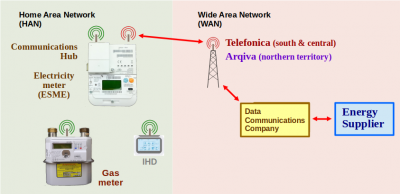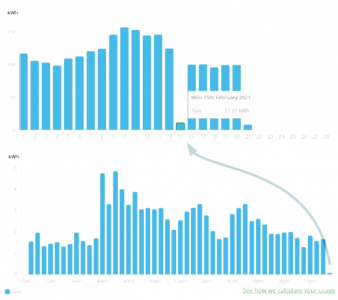Hi all, back in July and in preparation for the installation of an ASHP, we asked EDF to switch us over from an Economy 9 tariff to a standard one. This entailed installing a smart meter - firstly on an E7 tariff, then to transition to a standard tariff. It's been a long and very frustrating wait - missed appointments, registering the smart meter with the national grid, and more... Now that that's all done, there's yet another delay - apparently for the meter to be switched to a standard tariff. It's probably my frustration surfacing but is it technically credible for this switchover from E7 to take more than a week and counting? Our ASHP is due to be installed in just over a week's time and it would be nice to get this out of way by then. Thanks.
@fabz - you are seeing the effect of two different issues, which look like they're one and the same from the consumer's viewpoint.
1: The migration to having a Smart Meter is not instantaneous.
After the installation engineer leaves site, there is a sequence of commissioning which gets performed by the Data Communications Company (DCC).
They check the two or three radio-frequency communication channels which may be present on the Communications Hub, which sits on top of the Electricity Meter (ESME).
The manufacturers of the Comms Hub and the ESME may also have released firmware upgrades for those devices since they were delivered to your Supplier, EDF.
The Comms Hub has a secure Key to prevent unauthorised access. This gets registered with the relevant databases.
The ESME gets added to ECOES, the national database of all electricity meters.
They cross check the readings which the Installer reported were showing on the old meter which he/she removed.
ECOES notifies your Supplier, allowing them to adjust any discrepancies for billing purposes.
There are in-built time-lags in this process to enable each party to flag anomalies which might indicate
- previous/historical billing errors
- theft of electricity
- incorrect MPAN, perhaps not assigned to the correct address/postcode
- building ownership (a known problem where a property has been rented from a private landlord)
- identity fraud, whereby an individual might be using a utilities bill to open a bank account
2: The meter is then assigned to your chosen Supplier (EDF).
They should download your agreed tariff into the meter, which is how the In-home Device (IHD) allows you to set weekly budgets.
They can also add enhanced functionality on top of the manufacturer's basic firmware code.
EDF should create a bill which covers the cross-over between the old and new meters, and the old/new tariffs.
There is another pause. Under the Financial Services Act, you have a mandatory 14-day cooling-off period during which you can object to the bill, challenge the accuracy of the tariff by comparing with what you were offered, and settle any other disputes via the Ofgem-regulated Complaints Procedure.
Without knowing the exact timescales which apply to your meter replacement, it isn't going to be possible for us Forum Members to provide a definitive answer as to where you are in this sequence, nor what 'delay' has caused you to think that there's something untoward with how EDF are handling this.
We should, however, be pleased that these underlying procedures are robust and secure.
I have twice encountered situations whereby utility bills for my address were being directed to third-parties unknown to me.
Those potential frauds and ID-thefts were prevented because the UK system protects us.
For obvious reasons I have not provided details above of how the fraud works, nor how the meter security mechanisms operate!
Save energy... recycle electrons!
- @transparent - Thank you so much for the explanation. I had no idea that the transfer process was so complicated. I'm at the point in the sequence where the meter has been assigned to my supplier and has been updated to single rate on the system. We're now waiting for 'communication to reach the meter' - which is the delay I was questioning. After that's done, adjustments to charges will be made to compensate for the enforced Economy 7 period. Your reply has put my mind at ease and I'll wait more patiently for the process to end. Thanks.
@Transparent If I might resurrect this interesting thread....
Early last month Octopus were unable to bill me for gas. When I queried, they asked me to supply a meter reading but since I am on their Tracker tariff I politely declined. I didn't understand why Octopus had an issue as I was still able to download my half-hourly consumption data from other sources (e.g. n3rgy). Octopus initiated a 'gas meter reset' and a few days later I received an up-to-date bill. However, this included a period of a few days for which I was unable to download my consumption details, even from the Octopus customer portal.
The system now seems to have stabilised (hopefully) and I can now access my consumption data (from several sources). I am interested in how the data is collected, though. Is it collected from the DCC or does the DCC issue a token to permit connection to the meters (or gas meter proxy or Communications Device) directly? How about my In-Home Display and my Consumer Access Device (an Octopus Home Mini)? Since these are local devices, perhaps the same level of security is not appropriate. Do these have a different route to accessing meter data or is it possible that these could be 'locked-out' at some point?
@ianmk13 Our smart metre is a SMETS1 with some form of on-line update (during our days with Eon) OE were able to connect to it and I have Agile working well most of the time. We experience hiccups every so often and sometimes wait weeks before OE have the data to complete a bill. I am still awaiting on a long promised Octopus Mini which I think will give us more topical data. We will get there eventually but it would be nice if the system performed more reliably. Regards, Toodles.
Toodles, heats his home with cold draughts and cooks food with magnets.
@toodles There are many people who are anti-smart-meter. It wouldn't surprise me if there was a large intersection of the set of those people and the set of people who are anti-heat-pumps 😉. It is in the news again today that there are almost 4 million smart meters that aren't working in smart mode. This just adds fuel to the fire. I suspect that they may be SMETS1 meters (my meter is SMETS2) and it would be interesting to know just what the problem is with these, too. Is it an incorrect communications protocol, an issue with the security credentials, or something else? Can it be fixed with a firmware update? If so, does it require a site visit? How did the industry get itself in this situation?
Posted by: @ianmk13@toodles There are many people who are anti-smart-meter. It wouldn't surprise me if there was a large intersection of the set of those people and the set of people who are anti-heat-pumps 😉. It is in the news again today that there are almost 4 million smart meters that aren't working in smart mode. This just adds fuel to the fire. I suspect that they may be SMETS1 meters (my meter is SMETS2) and it would be interesting to know just what the problem is with these, too. Is it an incorrect communications protocol, an issue with the security credentials, or something else? Can it be fixed with a firmware update? If so, does it require a site visit? How did the industry get itself in this situation?
Yes, a lot of the people who are anti smart meter will be anti heat pump, because their favourite columnist or conspiracy theorist, but I repeat myself, told them they were bad. (Things are confused even more by the bots etc)
We have a smets2 meter installed last year but it isn't smart due to no signal or a mistake in installation, they weren't clear, but Octopus have told me they will be coming out to look at it at some point. I was talking to someone some years ago now who had been involved in smart meter installations and I do recall he said hang on until smets2 because the gvt and industry had totally messed it ul with smets1. Plenty of blame to go around, the problems were clear enough to those on the ground but not in board rooms and westminster.
@ianmk13 I think ours fails to ‘phone home’ every so often! This leaves OE with a ‘hole’ in the data for one or two days. Regards, Toodles.
Toodles, heats his home with cold draughts and cooks food with magnets.
Posted by: @ianmk13It is in the news again today that there are almost 4 million smart meters that aren't working in smart mode. This just adds fuel to the fire. I suspect that they may be SMETS1 meters (my meter is SMETS2) and it would be interesting to know just what the problem is with these, too. Is it an incorrect communications protocol, an issue with the security credentials, or something else? Can it be fixed with a firmware update? If so, does it require a site visit? How did the industry get itself in this situation?
There are a great many layers in the questions you're posing here, Ian.
Allow me to first give some clarifications.
We can then better understand the issue you've raised regarding the data loss from your Gas Smart Metering Equipment (GSME).
1: SMETS1 meters were licensed to be installed before the national smart meter network was designed and built.
They used a variety of different wireless mechanisms to send their data to your chosen Energy Supplier.
That's why some became un-smart if you switched Supplier to one who had implemented a different network path.
2: All SMETS1 sites should by now have been changed to operate using the SMETS2 specification.
That was actioned by Energy Suppliers sending an over-the-air software update to their customers.
Since meters are manufactured by a number of different companies, the relevant software for each meter was provided to Suppliers by the manufacturers.
Following the software update, each SMETS1 meter was migrated across to the national network, operated on our behalf by DCC (the Data Communications Company).
In some cases that migration failed. There are a number of possible reasons, but only rarely has it been necessary to implement an exchange which requires a site visit.
3: No data transfer can be initiated by your Smart Meter (or more properly, by the Communications Hub).
To obtain consumption data, a SMETS Command is sent to it by your Energy Supplier.
The Comms Hub responds to that Request.
Since the Comms Hub can hold the last 13-months of data within it (48-readings per day for electricity & gas), any period when there has been a loss of communication can be 'made good'.
If, in the meantime your Supplier's Billing Software has used estimated readings, then these are substituted with the actual readings, and an adjustment made to the bill.
4: A Gas Meter (GSME) acts like a sloth to conserve battery life.
It wakes up every 1800-seconds (a half-hour) to establish communication with the Comms Hub using the short-range Home Area Network (HAN).
Any data request messages in either direction are executed, and it then goes back to sleep.
Since data transfers will themselves occupy a finite amount of time, the GSME awakening will gradually move forwards in time.
Your Energy Supplier's data request will always be responded to by the Comms Hub, not the GSME itself.
If the Supplier requests the 'previous days readings' too soon after midnight, for example, then there will be occasions when only 47 of the 48 readings have been stored.
That's why you sometimes see a missing entry or an estimated reading for the last period of that day.
Occasionally there have been mistakes made by the Suppliers' billing software which makes a real mess of handling an estimate for the last reading of the day.
Here's one I saved from 15th Feb 2021 where the billing software applied a low estimate of the 48th reading, and then assumed that low figure applied to the whole day, even tho' it had actually received 47 correct readings!
The billing software obviously 'noticed' the error when it collected readings for 16th Feb just after midnight on 17th.
It then apportioned the missing gas consumption from 15th across the next 5 days, artificially making those day's bars on the histogram larger than they really were. (It was a warm week).
Just as the software was getting itself back in sync, the Supplier then collected the data for 21st too early again (too soon after midnight).
So it too has a very low estimate.
I'm afraid this sort of issue is well beyond the level of technical understanding you're likely to receive by telephoning Customer Services.
For that reason I always recommend taking screenshots over several days, and sending them in by email.
You then stand a chance of getting the error escalated to an in-house engineer who does actually understand the communications between a GSME and a Comms Hub!
5: If/when your Supplier needs to send software updates or change the configuration settings in your GSME, it will inevitably be asleep!
For that reason, each Comms Hub has a Virtual Gas Meter within it!
That acts as if the gas meter itself has received the software and/or commands, which means an acknowledgement is sent to the Supplier via DCC.
When the GSME next awakens, the Virtual Gas Meter transfers whatever is required to the actual meter.
Should that transfer across the HAN fail, it could theoretically leave the GSME in a state where correct daily readings are no longer available.
Once you tell your Supplier that something appears to be wrong, they can send a SMETS Reset command...
... and then attempt the software upgrade again.
Personally I think it shouldn't be necessary for the customer to contact the Supplier.
By now the Billing Software itself should be using a sanity-check to test if valid data is being received.
For goodness sake... this is 2024!
Save energy... recycle electrons!
I am particularly interested in how the DCC fits into the picture. Does my energy supplier send a request for meter data through the DCC and receive meter data back via the DCC? Your diagram suggests this is the case. Do third parties (e.g. n3rgy) access meter data through the DCC in the same way? You made an interesting point regarding the gas meter sleeping for a fixed period, rather than waking at a fixed period, which I hadn't considered.
The final section of your reply seems to be a good explanation of what probably went wrong in my case. I'm surprised, though, that the communications protocol between the GSME and Gas Proxy in the Communications Hub isn't more robust, to include a verification message back from the GSME to confirm a correct upload of data. Given that I've now received three 'Welcome to Octopus' messages on my In Home Display in the past few days, should I conclude that this is considered to be an unreliable process. As you say, it's 2024! Maybe we have to wait until the next iteration of Comms Hub.
I've been looking very closely at my gas consumption this winter to help me to determine future heat pump requirements. Whereas I can usually get gas volume figures to tally, getting my kWh figures to agree with my bill is another matter. This may be a result of the asynchronicity of the meter readings, but could be exacerbated by the variations in calorific value (or even a different precision in the calculations). If only I could be as confident in my gas bill as I am with my electricity bill.
- 26 Forums
- 2,417 Topics
- 54.8 K Posts
- 413 Online
- 6,096 Members
Join Us!
Worth Watching
Latest Posts
-
RE: Octopus Cosy 12 Heat Pump Regret: Incredibly Loud, Poor Heating & Constant Hum - Help!
Well done for identifying it, thats half the battle. S...
By JamesPa , 11 minutes ago
-
MLCP (Multi-Layer Composite Pipe) for ASHP
@editor nope. The info you reported was sufficient for ...
By iotum , 10 hours ago
-
RE: Advice for a novice on Mitsubishi Ecodan 6kW
@robs Quick response while I'm in stationary traffic le...
By Sheriff Fatman , 10 hours ago
-
RE: Setback savings - fact or fiction?
Maths looks right to me, my only question about this ca...
By JamesPa , 11 hours ago
-
RE: Ideal HP290 14kW ASHP - how to optimise
@jamespa I wasn’t offended at all. You are very knowled...
By Davesoa , 11 hours ago
-
RE: Experience - New Build / Complete New Heating System
@vincro I would be surprised if it is much above 5 to 6...
By ASHP-BOBBA , 11 hours ago
-
RE: Recommended home battery inverters + regulatory matters - help requested
Yes, certainly not enough could have been tested in any...
By Batpred , 12 hours ago
-
RE: Post-Traumatic Heat Pump Stress Disorder
Yes bang on and maybe I can illustrate that by way of e...
By iotum , 14 hours ago
-
-

RE: Replacing my 18 month old Hitachi Yutaki ASHP
A big thank you to @jamespa for all his efforts online ...
By trebor12345 , 17 hours ago
-

RE: GSHP WOES! Midland based engineer recommendations?
@editor It is indeed for servicing. My current service ...
By Morgan , 17 hours ago
-
RE: Sunsynk Whole House Backup Issue
Hi @lostandconfused , I agree that topic/thread is the ...
By Batpred , 18 hours ago
-
RE: Speedcomfort radiator fans
In case it helps Andrew Kuhne on openenergy monitor has...
By JamesPa , 18 hours ago
-

Things have gone quiet with you @drei. Any updates?
By Mars , 21 hours ago
-

RE: Passiv Smart Thermostat - Help & Forum Support
Thanks @tim441. Interesting timing, as Passiv are a cur...
By Mars , 23 hours ago
-
Hi everyone, I have a two year old Marlec Solar iBoos...
By Tallmarc , 1 day ago
-
RE: Please help with the settings ecodan
Are you trying to address any particular performance is...
By Sheriff Fatman , 1 day ago
-
RE: Solis inverters S6-EH1P: pros and cons and battery options
🤣 Well, I never managed to get the HA solis "...
By Batpred , 1 day ago







